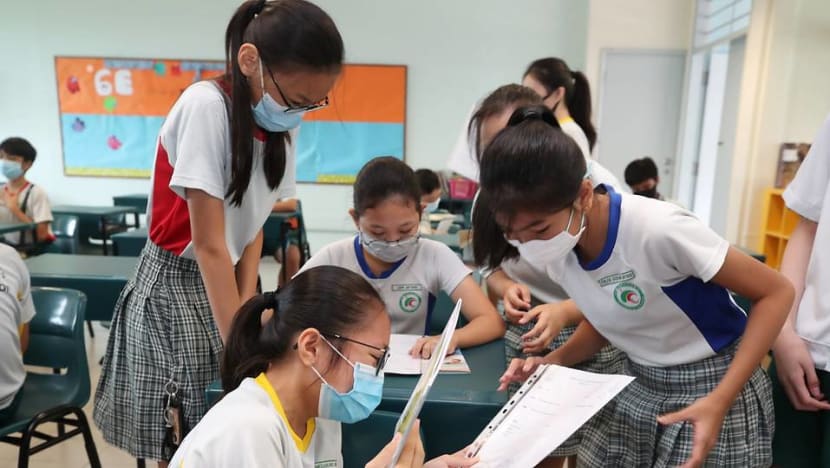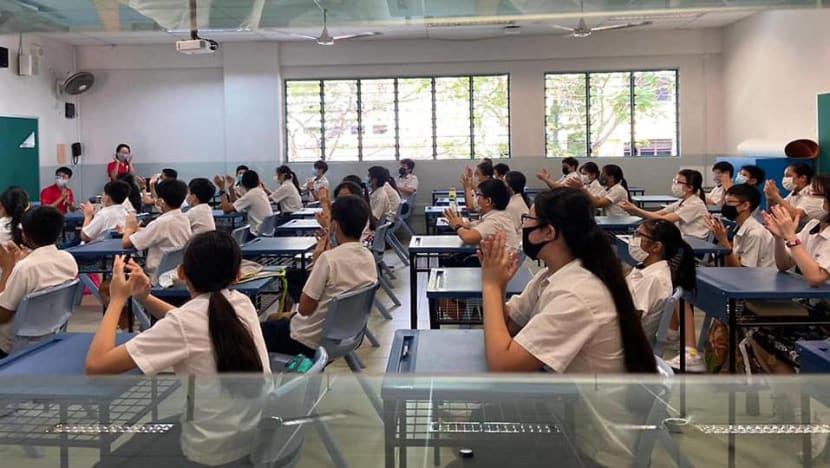Commentary: Why scrapping mid-year exams is giving some parents more anxiety than relief
As Singapore’s education system pivots towards less testing and deeper learning, parents, student and teachers need to understand how and why we test, says NIE’s Jason Tan.

Students at Northoaks Primary School collect their PSLE results on Nov 25, 2020. (Photo: Facebook/Lee Hsien Loong)
SINGAPORE: On Monday (Mar 7), the Education Ministry announced the removal of mid-year examinations in all primary and secondary schools by 2023.
Parents are perennially concerned about the Singapore education system being stressful for children, yet this news was met with mixed reactions.
Online, some parents didn’t hide their anxiety: How will they know if their child has mastered the concepts? Wouldn’t this simply be replaced with other forms of assessment that will be just as stressful, or worse, fuel the demand for private tuition?
And doesn’t this suddenly raise the stakes of the end-year examinations?
Far from being a bolt out of the blue, this follows changes to assessment policies over the last decade. All Primary 1 examinations and Primary 2 mid-year examinations were removed in 2010. Mid-year examinations for Primary 3 and 5 and Secondary 1 and 3 were also removed between 2019 and 2021.
And reducing the stress permeating the school system and the competitive focus on academic grades has been a key objective. Another has been the promotion of the joy of learning by moving away from memorisation and rote learning.
Education Minister Chan Chun Sing said in Parliament that such changes have had a positive impact: Teachers could “better pace and deepen learning”.
With several weeks of curriculum time freed up from examination preparation, teachers could focus on more inquiry-based learning and critical life skills, and less chalk and talk.

MISMATCH IN HOW PARENTS AND TEACHERS SEE ASSESSMENTS
So, if removing examinations can help take away excessive stress for students, why are parents so anxious?
The reality is that many parents see assessments predominantly in terms of sorting and accountability.
Academic assessments essentially collect information to sort students into different classes, tracks or schools. The Primary School Leaving Examination (PSLE) is seen as the milestone sorting mechanism by most.
These assessments are often summative. They focus on summarising how much students have learnt and provide valuable input on how much more is needed to do better.
Assessments also provide accountability by informing parents about how well their children are performing, which parents and students use to select courses of study, schools or even career paths.
Little wonder that parents are feeling anxious, if they perceive the removal of mid-year examinations as losing an indicator of performance that could disadvantage their child in the preparation for the PSLE or other milestone sorting examinations, or missing out on a valuable checkpoint that indicates learning gaps.
Some of the anxiety may also be caused by the assumption that students will take examinations more seriously than periodic weighted assessments. In addition, there may be worries that these assessments may actually spread the stress over a longer period of time and across more varied forms of assessment that parents may be less familiar with.
CHANGING HOW WE SEE TESTING
But in schools, assessments are also seen to be formative. They help identify students’ strengths and weaknesses in learning. They guide teachers to address gaps in understanding and refine their pedagogical strategies.

A central part of a teacher’s work is to test understanding of what has been taught. There is a traditional concept, one which all of us grew up with, which is the assessment of learning.
Then there’s another aspect - assessment for learning, using it as a form of feedback to help students understand their own learning and formulate learning goals.
An assessment of learning approach might involve administering a test and returning the marked work to students. Comments such as “Well done” or “You need to work harder” convey the importance of attaining a threshold.
In contrast, assessment for learning involves much more. The teacher has to find out what level students are at, provide feedback on how to improve learning, and then guide them towards understanding what success looks like in each task. In this case, the process of learning matters and teachers have the ability to adjust their methods to cater to different needs.
For instance, teachers may break the task of adding fractions up into different levels of complexity, with the help of concrete teaching aids where necessary. Students who understand the concept better would be able to complete basic, intermediate and perhaps even advanced level tasks.
At the same time, some students may do well in basic and intermediate tasks but struggle with more complex problems, while others may only be able to handle basic tasks.
Both the students and the teacher can identify where the gaps in understanding are and teachers can then provide further additional scaffolding to reach the desired standard. Here, the student is encouraged to be more independent and to assess their own levels of learning (did they do well, where did they struggle and how did they improve).
Case studies have shown that this method improves a child’s interest and independence – they enhance abilities to take action and consolidate learning.
ACTIVE LEARNING IS THE GOAL
Academic research indicates that this sort of learning leads to students becoming more active and involved in the learning process, thereby gaining confidence in what they are expected to learn and to what standard.
Schools and stress: Listen to CNA's Heart of the Matter podcast dissect this tangled web involving parents, academic pressure and so much more.
According to the Centre for Educational Research and Innovation (CERI), these learning strategies are especially useful in helping low-achieving students to enhance their learning, as they gradually learn to overcome their fear of taking risks and making mistakes.
A research paper put out by CERI notes: “Several studies show that formative assessment methods have an even stronger impact for underachieving students. Selected studies focus on teaching which stresses the importance of effort over ability, or of task-centred feedback (as opposed to ego-involving feedback).”
The Education Ministry is trying to incorporate more of this sort of learning into the system and has identified Assessment Literacy as a key skill for educators. Teachers will need to stay abreast of the latest developments in the design and use of assessment tools to improve the way students learn.
This recalibration will take time, but it cannot be one-sided on the part of teachers. Parents must meet them halfway in reinforcing the importance of “learning how to learn” and developing skills that extend beyond preparing for blunt assessments.
I can understand why some parents are anxious about this latest removal of mid-year examinations. As long as there is a national preoccupation with high-stakes examinations, it will likely take more time for parents, students and teachers to look beyond the weight of academic scores on a child’s future.
And though we’re no longer in school, we too need to learn how to make assessments of learning and assessments for learning work in tandem to make learning a more meaningful and less anxiety-wrought experience for all students.
Jason Tan is an Associate Professor at the National Institute of Education.

















